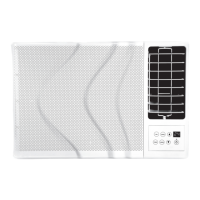4-3
To remove the refrigerant charge:
a. Install a manifold gauge set as outlined in
section 4. 3.
b. Connect evacuated refrigerant cylinder to the
liquid line valve at the inlet valve of the filter-drier. The
service line to the liquid valve of the cylinder should be
attached loosely. Crack open the liquid line valve
momentarily to purge service line at cylinder. Tighten
connection at cylinder.
c. Place evacuated refrigerant cylinder on scale and
note weight of empty cylinder. Leave cylinder on scale.
d. Frontseatliquidlinevalveatthe inletofthefilter-
drier.
e. Runtheunitinhighspeedcoolwiththecondenser
coil completely blocked off. Head pressure will quickly
rise. Stop the unit whenthe system pressure reaches 250
psigforR-22systemsor150psigforR-134asystemsusing
the run control switch.
f. Fully open the refrigerant cylinder liquid valve.
Liquid refrigerant will flow from the liquid line valve to
the cylinder. Head (discharge) pressure will drop.
g. Monitor weight of the refrigerant cylinder to
determine how much refrigerant is being removed. Shut
off cylinder valve when the scale weight has stabilized,
indicating the refrigerant flow into the cylinder has
stopped. Run the unit for a few more minutes to
condense more liquid and raise head pressure.
NOTE
Refrigerant will flow from the system to the
cylinder until the pressures equalize. It is
possible to remove more refrigerant by cooling
the refrigerant cylinder in a container of ice.
h. Backseattheliquidlinevalveandremovecylinder
hose.
i. Serviceorreplacethenecessarycomponentinthe
system.
NOTE
Whenopeninguptherefrigerantsystem,certain
parts may frost. Allow the part to warm to
ambient temperature before dismantling. This
avoids internal condensation which puts
moisture in the system.
4.6 REFRIGERANT LEAK CHECK
A refrigerant leak check shouldalways be performed
after the system has been opened to replace or repair a
component.
To check for leaks in the refrigeration system,
perform the following procedure.
a. Ifsystemiswithoutrefrigerant,chargesystemwith
refrigeranttobuilduppressurebetween30to50psig(2.1
to 3.5 kg/cm@).
NOTES
1. It is recommended that the appropriate
refrigerant used, be used to pressurize the
system.
2. Under no circumstance should the system be
pressurized above 100 psig when leak testing.
b. Checkforleaks.Therecommendedprocedurefor
finding leaks in a system i s with a halide torch or
electronic leak detector.
c. Remove the refrigerant used to pressurize the
system prior to leak repair using a recovery system.
d. Repeat the enti re procedure if necessary.
e. Evacuateand dehydratethe systemas outlinedin
section 4.7.
f. Charge the unit as outlined in section 4.8.1.
4.7 EVACUATION AND DEHYDRATION
Proper evacuation and dehydration procedures are
imperative when service repairs or component
replacement are performed on the system to ensure
proper unit performance and long compressor life.
The results of improper evacuation are harsh.
Noncondensibles gases in the system result in high head
pressure; moisture may cause ice blockage a t the
expansion valve; moisture and refrigerant may react to
form an acid. This acid may cause copper plating of the
bearing surfaces and eventual compressor failure.
a. Equipment Needed
1. Vacuum Pump --- A good vacuum pump (3 to 5 cfm
volume displacement, at atmospheric pressure) A pump
of this capacity is available through the Carrier Service
Parts, CTD P/N 07-00176-01.
2. Thermistor Vacuum Gauge --- A thermistor
vacuum gauge (electronic vacuum gauge) measures the
low absolute pressures necessary to remove moisture
from the system. A compound gauge (manifold gauge set)
is not recommendedbecauseof it’s inherent inaccuracy. A
vacuum gauge is available from a refrigeration supplier.
3. EvacuationHoses --- Three 3/8” evacuation hoses,
the length to be determi ned by the application of the
service set-up. 3/8 to 1/4 adapter connector are also
needed to make compressor connections. (Evacuati on
hoses and adapters are available from your local
refrigeration supplier.) Do not use standard
refrigeration hoses to evacuate. These standard hoses
are designed for pressure not vacuum and may collapse
during evacuation.
4. Recovery System --- A refrigerant recovery system
is recommended for removing the refrigerant.

